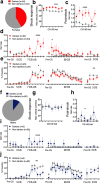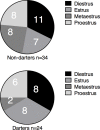Sexually divergent expression of active and passive conditioned fear responses in rats
- PMID: 26568307
- PMCID: PMC4709260
- DOI: 10.7554/eLife.11352
Sexually divergent expression of active and passive conditioned fear responses in rats
Abstract
Traditional rodent models of Pavlovian fear conditioning assess the strength of learning by quantifying freezing responses. However, sole reliance on this measure includes the de facto assumption that any locomotor activity reflects an absence of fear. Consequently, alternative expressions of associative learning are rarely considered. Here we identify a novel, active fear response ('darting') that occurs primarily in female rats. In females, darting exhibits the characteristics of a learned fear behavior, appearing during the CS period as conditioning proceeds and disappearing from the CS period during extinction. This finding motivates a reinterpretation of rodent fear conditioning studies, particularly in females, and it suggests that conditioned fear behavior is more diverse than previously appreciated. Moreover, rats that darted during initial fear conditioning exhibited lower freezing during the second day of extinction testing, suggesting that females employ distinct and adaptive fear response strategies that improve long-term outcomes.
Keywords: active responses; fear conditioning; neuroscience; rat; sex differences.
Conflict of interest statement
The authors declare that no competing interests exist.
Figures







Comment in
-
Fight, Flight, or Freeze? The Answer May Depend on Your Sex.Trends Neurosci. 2016 Feb;39(2):51-53. doi: 10.1016/j.tins.2015.12.010. Epub 2016 Jan 6. Trends Neurosci. 2016. PMID: 26776563
References
-
- Fanselow MS. Conditioned and unconditional components of post-shock freezing. The Pavlovian Journal of Biological Science. 1980;15:177–182. - PubMed
MeSH terms
LinkOut - more resources
Full Text Sources

